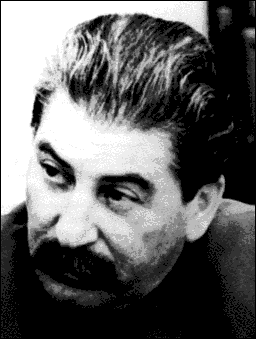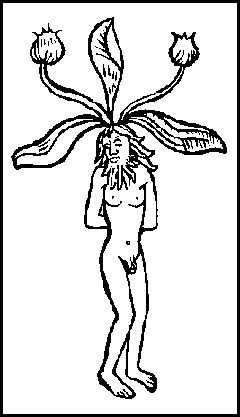Starmaker
Olaf Stapleton
(Wesleyan University Press)

1928 was the year of the Shakhty trial of engineers on bogus charges of "wrecking." Following it there were mass administrative purges of thousands of engineers who were deprived of civil rights and ration cards. In 1929 the purge spread to thousands of agronomists, statisticians, economists, and civil servants for "sabotage," "right-wing deviations," or "membership in a socially alien class."
The witchhunts of 1928-31, dress rehearsals for the broader terror of 1934-1937, were explicitly aimed at finding scapegoats for the failures of industry and agriculture under the Bolsheviks' "devoted but ruthless dictatorship." In short, the hunt for heretics very quickly became the dominant feature of what Leftists of Stapleton's generation liked to call "the Bolshevik experiment."
One need not imagine a science fiction planet of the Leftoids to probe this mentality. Here on our own planet, we need only contemplate Lenin's embalmed corpse in 1924, preserved under glass for worship like the bones of a medieval saint, or the idolatry of the Dear Leader of N. Korea (a hereditary position) in any year from 1948 on. Nor is this mentality limited to exotic locales like Moscow or Pyongyang: here is an example taken from a leaflet issued in Chicago in 2005.
- WHO IS BOB AVAKIAN?
Anyone serious thinking about revolution knows that it can't happen without revolutionary leadership. It's a huge question.
Well, just to be up front, there IS a leader, the like of which this country has never seen before, that can lead a mighty struggle to make revolution and remake society. That leader is Bob Avakian, Chairman of the Revolutionary Communist Party.
Chairman Avakian knows revolution. He has studied deeply the revolutions of the past and taken up the responsibility for charting the course of revolution today. He has done a whole "re-envisioning" of communist society and what it will take to get there. He's a leader with tremendous love for and confidence in the people; and he gives you confidence and hope that we can actually do what the times demand of all of us. ....We in the RCP are fully aware that someone like Bob Avakian comes along only very rarely, and we take seriously our responsibility to defend this precious leader from the powers-that-be---and to rally others to do so as well.
www.rwor.org
www.bobavakian.net
 Stapleton's aversion to machines and technology, so characteristic of British academic Leftists to this day, comes through loud and clear in another of my favorite tales in The Starmaker. This one is of a world inhabited by plant-men, who are walking, talking shrubbery. Originally, the plant-men divide their days and nights into radically different ways of life. By day, they connect themselves to detachable roots, spread their foliage to catch the sun, and stand placidly photosynthesizing in a sort of vegetable trance. But after the sun sets, they detach from their roots and go about normal animal activities: hunting, gathering, science and industry, working at the office, shopping at the mall, things like that. In time, with the advance of science and technology, they devote more and more of their lives to night-time animal pursuits. Then, the development of artificial photosynthesis frees them from the need to spend any time at all on the vegetable side, and they go entirely animal, with temporarily baneful results.
Stapleton's aversion to machines and technology, so characteristic of British academic Leftists to this day, comes through loud and clear in another of my favorite tales in The Starmaker. This one is of a world inhabited by plant-men, who are walking, talking shrubbery. Originally, the plant-men divide their days and nights into radically different ways of life. By day, they connect themselves to detachable roots, spread their foliage to catch the sun, and stand placidly photosynthesizing in a sort of vegetable trance. But after the sun sets, they detach from their roots and go about normal animal activities: hunting, gathering, science and industry, working at the office, shopping at the mall, things like that. In time, with the advance of science and technology, they devote more and more of their lives to night-time animal pursuits. Then, the development of artificial photosynthesis frees them from the need to spend any time at all on the vegetable side, and they go entirely animal, with temporarily baneful results.
"A disease of robotism, of purely mechanical living, spread throughout the population. There was of course a fever of industrial activity. The plant men careered around their planet in all kinds of mechanically propelled vehicles, decorated themselves with the latest synthetic products, tapped the central volcanic heat for power, expended great ingenuity in destroying one another, and in a thousand other feverish pursuits pushed on in search of a bliss which ever eluded them."
- After untold distresses they began to realize that their whole way of life was alien to their essential plant nature. Leaders and prophets dared to inveigh against mechanization and against the prevalent intellectualistic scientific culture, and against artificial photosynthesis. By now, nearly all of the roots of the race had been destroyed; but presently biological science was turned to the task of generating, from the few remaining specimens, new roots for all. Little by little the whole population was able to return to natural photosynthesis. The industrial life of the world vanished like frost in sunlight. In returning to the old alternating life of animal and vegetable, the plant men, jaded and deranged by the long fever of industrialism, found in their calm daytime experience an overwhelming joy. The misery of their recent life intensified by contrast the ecstasy of the vegetal experience....
Little by little, they gave less and less energy and time to "animal" pursuits, until at last their nights as well as their days were spent wholly as trees, and the active, exploring, manipulating, animal intelligence died in them for ever.
In short, the whole race of plant-men turned on, tuned in, and dropped out. Too bad Olaf Stapleton didn't survive into the 1960s, which he would surely have enjoyed. Think about it this way: if it is a trip just to smoke a marijuana weed or eat a peyote plant, imagine what it must be like to BE ONE.